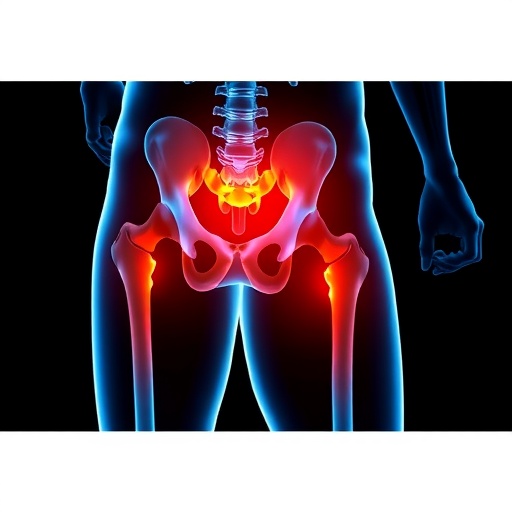A Northwestern University research team has developed a first-of-its-kind soft, flexible microfluidic device that easily adheres to the skin and measures the wearer's sweat to show how his or her body is responding to exercise.
A little larger than a quarter and about the same thickness, the simple, low-cost device analyzes key biomarkers to help a person decide quickly if any adjustments, such as drinking more water or replenishing electrolytes, need to be made or if something is medically awry.
Designed for one-time use of a few hours, the device, placed directly on the skin of the forearm or back, even detects the presence of a biomarker for cystic fibrosis. In the future, it may be more broadly used for disease diagnosis.
"The intimate skin interface created by this wearable, skin-like microfluidic system enables new measurement capabilities not possible with the kinds of absorbent pads and sponges currently used in sweat collection," said John A. Rogers, who led the multi-institution research team that created the 'lab on the skin.'
"Sweat is a rich, chemical broth containing a number of important chemical compounds with physiological health information. By expanding our previously developed 'epidermal' electronics platform to include a complex network of microfluidic channels and storage reservoirs, we now can perform biochemical analysis of this important biofluid," he said.
Rogers is the Louis Simpson and Kimberly Querrey Professor of Materials Science and Engineering, Biomedical Engineering and Neurological Surgery in the McCormick School of Engineering and Northwestern University Feinberg School of Medicine.
Rogers and his longtime collaborator Yonggang Huang are pioneers in developing skin-like stretchable electronics that move naturally with the skin, and this is their first device to monitor physiological health by analyzing biofluids.
"We already know how to put electronics on the skin in a natural manner — here our challenge was dealing with fluid flow and the collection, storage and analysis of sweat in a thin, soft and flexible device," said Huang, who worked on the device's design and optimization.
"The sweat analysis platform we developed will allow people to monitor their health on the spot without the need for a blood sampling and with integrated electronics that do not require a battery but still enable wireless connection to a smartphone," he said.
Huang is the Walter P. Murphy Professor of Civil and Environmental Engineering and Mechanical Engineering at the McCormick School.
In a study of accuracy and durability, the device was tested on two different groups of athletes: one cycling indoors in a fitness center under controlled conditions and the other participating in the El Tour de Tucson, a long-distance bicycle race in arid and complex conditions. The researchers placed the device on the arms and backs of the athletes to capture sweat.
Details of the versatile platform for sweat analysis will be published Nov. 23 by the journal Science Translational Medicine.
During moderate or vigorous exercise, sweat winds through the tiny microscopic channels of the device and into four different small, circular compartments. In the compartments, reactions with chemical reagents result in visible color changes in ways that quantitatively relate to pH and concentrations of glucose, chloride and lactate.
When a smartphone is brought into proximity with the device, the wireless electronics trigger an app that captures a photo of the device and analyzes the image to yield data on the biomarker concentrations.
"We chose these four biomarkers because they provide a characteristic profile that's relevant for health status determination," said Rogers, director of Northwestern's Center for Bio-Integrated Electronics. "The device also can determine sweat rate and loss, and it can store samples for subsequent laboratory analysis, if necessary."
In the group that cycled indoors, the researchers compared the new device's biomarker readouts to conventional laboratory analysis of the same sweat and found the two sets of results agreed with each other. (Conventional methods include capturing sweat with absorbent patches taped to the skin and analyzing them off-site.)
With the long-distance cyclists, the researchers tested the durability of the device in the complex and unpredictable conditions of the desert. They found the devices to be robust: They stayed adhered to the athletes' skin, did not leak and provided the kind of quality information the researchers sought.
The sweat analysis device features a number of innovations:
- The device can capture, store and analyze sweat in situ in real time
- The device can quantitatively determine biomarker levels using colorimetric analysis
- A power source is not required to display the results; instead, a smartphone camera and app are used to read the biomarker change
The multidisciplinary work involved close collaborations with clinical investigators, including Dr. Marvin J. Slepian, at the Sarver Heart Center of the University of Arizona, as well as contributions from dermatology experts from L'Oréal, including Guive Balooch. Slepian and Balooch are co-authors of the study.
The title of the Science Translational Medicine paper is "A Soft, Wearable Microfluidic Device for the Capture, Storage, and Colorimetric Sensing of Sweat."
In addition to Northwestern, the University of Arizona and L'Oréal, other institutions with authors on the paper are the University of Illinois at Urbana-Champaign; Ajou University, Korea; Hanyang University, Korea; Zhejiang University, China; and MC10, Inc.
###
Media Contact
Megan Fellman
[email protected]
847-491-3115
@northwesternu
http://www.northwestern.edu
############
Story Source: Materials provided by Scienmag




